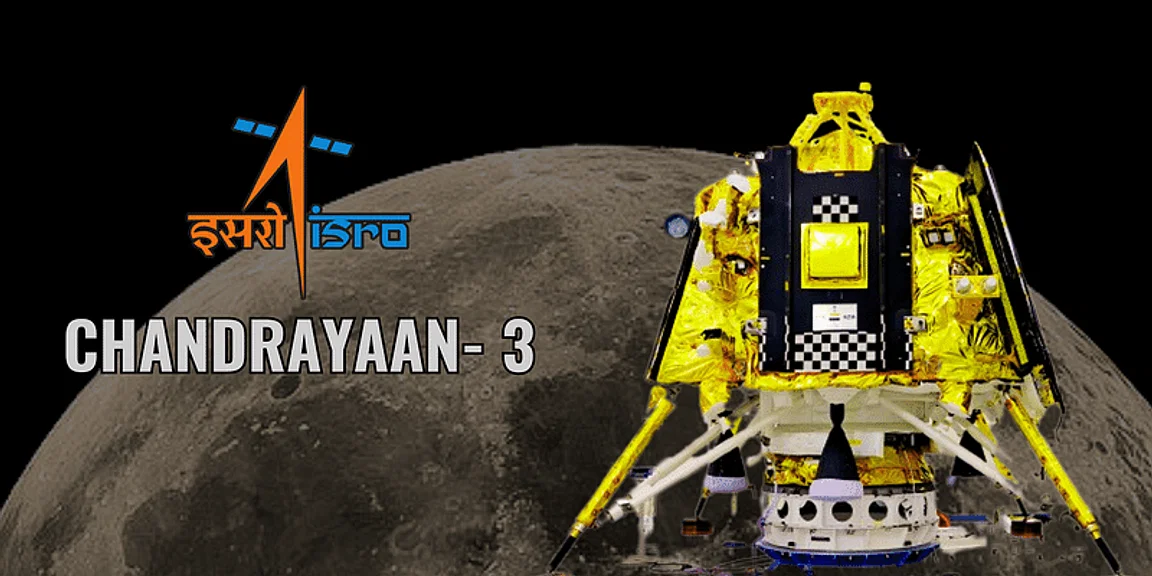In the heart of Bengaluru, India, moments of nail-biting tension yielded to jubilant cheers at the control center of the Indian Space Research Organization (ISRO) as the space agency etched its name in history by propelling its lunar lander, along with India, into the annals of time. On August 23, at 12:33 P.M. UTC, the robotic lander of India’s Chandrayaan-3 mission, named Vikram, gracefully touched down on the moon’s southern pole. Following the unfortunate mishap of its Chandrayaan-2 mission in 2019, ISRO launched Chandrayaan-3 on July 14, doubling down on its commitment to lunar landing. With the successful moon landing, India’s persistence bore fruit, elevating the nation to the ranks of the former Soviet Union, the U.S., and China as the fourth country to achieve a soft lunar touchdown.
Chandrayaan-3’s entire lunar descent was meticulously orchestrated to be fully autonomous. During this critical phase, the transmission of signals from the lander to Earth and back took around three seconds—an interval too extensive for terrestrial ISRO engineers to provide real-time guidance for the landing. Hence, Vikram’s mission was to decelerate its high orbital speed to a standstill, thereby ensuring it adhered closely to its intended path until a secure landing could be executed. Achieving this demanded precise orchestration of engine firings based on continuous assessments of distance, velocity, and orientation.
To secure a successful landing this time, ISRO integrated significantly more redundancies and safeguards into Chandrayaan-3 compared to Chandrayaan-2. In an enlightening discourse on August 5 that outlined these enhancements, S. Somanath, ISRO’s chief, emphasized how Chandrayaan-3 was equipped with enhanced fuel capacity and an improved guidance, navigation, and control system, capable of rectifying major deviations from the designated trajectory. “A total of 21 subsystems were enhanced for Chandrayaan-3, fortified through a series of meticulous ground tests involving helicopters and cranes,” stated Nilesh Desai, the director of ISRO’s Space Applications Center (SAC) in Ahmedabad, India.
The culmination of these improvements manifested in the triumphant touchdown of Chandrayaan-3. This achievement was far from certain, especially considering that four out of the six lunar landing endeavors in the past five years had met with failure. The most recent setback occurred on August 19 when Russia’s Luna-25 spacecraft encountered engine malfunctions, resulting in a crash landing on the moon—a stark reminder that traversing the lunar surface intact remains a perilous endeavor. Luna-25 now joins the ranks of SpaceIL’s Beresheet, India’s Chandrayaan-2, and ispace’s Hakuto-R spacecraft from Japan. Fortunately, Chandrayaan-3’s outcome mirrors the successes of China’s Chang’e 4 and Chang’e 5 missions, standing as the only other notable achievements.
“We are now entrusted with the significant responsibility of inspiring not only India but the entire world on a scale no less than the impact of this successful landing,” remarked Sankaran Muthusamy, the director of the U. R. Rao Satellite Center (URSC), the ISRO division responsible for conceiving and integrating the Chandrayaan-3 spacecraft and mission.
THE JOURNEY OF CHANDRAYAAN-3 TO THE LUNAR SURFACE
Chandrayaan-3’s lunar descent, spanning approximately 19 minutes, unfolded across four key phases. The first phase, known as the “rough braking” phase, commenced when the spacecraft hovered around 30 kilometers above the moon’s surface and approximately 750 kilometers from its intended landing site. By engaging all four of its 800-newton primary engines for nearly 12 minutes and reducing its altitude to 7 kilometers, Chandrayaan-3 succeeded in curbing its high horizontal velocity of roughly 1.7 kilometers per second by a remarkable 80 percent.
This was followed by a brief yet pivotal “attitude hold” phase lasting around 10 seconds. During this stage, the lander utilized eight smaller thrusters to stabilize itself, enabling its various landing sensors to obtain a steady view of the approaching lunar terrain.
To measure its altitude, Chandrayaan-3 relied on dual altimeters—one employing lasers and the other utilizing microwaves. While laser altimeters are commonplace in several lunar landers, they sometimes yield irregular readings, especially if the lander crosses rugged landscapes or large craters. Priyanka Mehrotra, the lead system designer of Chandrayaan-3’s Ka-Band microwave altimeter at SAC, explained that the microwave altimeter’s wider coverage enabled the spacecraft to better accommodate sudden altitude changes.
REVISITING PREVIOUS LANDING SETBACKS
Chandrayaan-3’s redundant altimetry systems held particular significance due to the role laser altimetry played in the unsuccessful landing attempt of ispace’s initial lunar lander on April 25. As the ispace lander approached its target landing site near the Atlas Crater, its laser altimeter correctly registered an elevation increase of approximately 3 kilometers, corresponding to the crater’s depth. However, onboard software designed to discard certain abrupt readings in order to stabilize the lander’s motion rejected this measurement as erroneous. Misinterpreting its proximity to the surface, the Japanese lander continued decelerating until it exhausted its fuel and crash-landed.
The attitude hold phase proved to be Chandrayaan-2’s Achilles’ heel. The lander’s engines generated slightly more thrust than expected due to a malfunctioning thrust control valve, leading to cumulative navigation errors over time. ISRO had programmed the onboard computer to rectify such deviations only after the attitude hold phase concluded. However, the disparity grew so rapidly that the lander couldn’t correct it in time, despite its capacity to modulate thrust.
In response, ISRO ensured that Chandrayaan-3 possessed the ability to swiftly detect and rectify deviations from its intended trajectory compared to its predecessor’s failures. Additionally, Chandrayaan-3’s lander incorporated a new instrument, a laser Doppler velocimeter (LDV), to enhance navigation accuracy. William Coogan, the lunar lander chief engineer at Firefly Aerospace, explained that the LDV directly measures velocity with respect to the ground, thereby minimizing the accumulation of navigation errors.
Subsequent to the demanding attitude hold phase, Chandrayaan-3 entered a three-minute “fine braking” phase, employing two of its four main engines to descend to an altitude of approximately 850 meters above the lunar surface before briefly hovering. This pause provided the lander an opportunity to capture images of the surface, which were then compared to preloaded satellite images to determine its proximity to the intended landing area.
Desai elaborated on Chandrayaan-3’s meticulous approach: “The target landing zone for Chandrayaan-3 spans four by 2.5 kilometers. ISRO experts divided it into 3,900 subsections of equal size, rigorously assessing the safety of each subsection for landing and incorporating this information into the lander’s reference data.” At this juncture, Chandrayaan-3 had two choices: if it found itself above the predetermined


